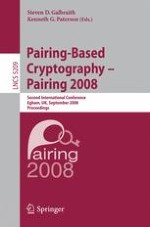2008 | Book
Pairing-Based Cryptography – Pairing 2008
Second International Conference, Egham, UK, September 1-3, 2008. Proceedings
Editors: Steven D. Galbraith, Kenneth G. Paterson
Publisher: Springer Berlin Heidelberg
Book Series : Lecture Notes in Computer Science








